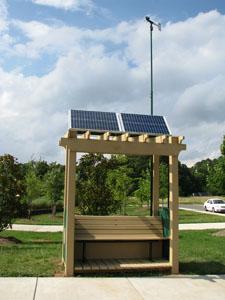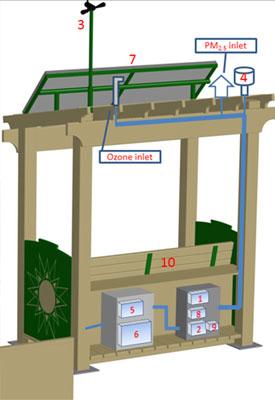Village Green Project

The Village Green Project is a community-based activity to demonstrate the capabilities of new real-time monitoring technology for residents and citizen scientists to learn about local air quality. The goal of the project is to provide the public and communities with information previously not available about their local air quality and engage communities in air pollution awareness.
A pilot station in Durham, North Carolina has demonstrated the system’s ability to monitor several common air pollutants in real-time and make the data available online and by smartphone. The Village Green Project is expanding to other communities across the U.S. to evaluate the station’s operation under different weather conditions and to increase awareness of this new community-based air quality monitoring system developed by EPA. The solar and wind powered station is a park bench structure with instruments that provide minute-to-minute air measurements for ozone, particle pollution and weather conditions.

- What does the Village Green station measure?
The station is a park bench structure made from recycled materials and includes sophisticated instruments to measure two common air pollutants -- fine particle pollution called PM2.5 and ozone – and meteorological conditions such as wind speed, temperature, and humidity. Weather conditions are important for understanding air quality.
- How do I access the data from the Village Green stations?
The data is being streamed live on the web with minute by minute updates. Users can access the data online or by their smartphone when physically at the station. The data are wirelessly transmitted from the stations by cellular modem, quality checked, and then posted to the website – all of this happens within several minutes of the air passing into the instruments. If you see gaps in the data, this may be due to either the system being powered down due to low battery power or if instrument maintenance is underway.
- How does the Village Green station operate?
A Village Green station contains air measurement instrumentation, miniaturized and low power computer technology, solar panels and communications equipment that is available to the public in the marketplace. The station is designed to wirelessly transmit data with automatic data quality checks in place. Powered by the sun and wind, Village Green stations can be sited in areas without access to power, transmit data wirelessly, and are designed to be easily located into a community environment.
- How can the data be useful?
Village Green station data is being used in research to improve understanding of air quality and to increase community awareness of local air quality conditions.
Research studies tell us that local air pollution levels can be affected by pollution sources located both nearby and far away. For example, EPA’s near-road research has shown that pollution levels immediately downwind of a highway can be higher than in places farther from a highway. Lower cost air monitoring technologies, like the Village Green Project, can allow researchers and citizens to monitor local air quality to understand how air pollution varies from place to place.
Beyond measuring the air and weather, the Village Green Project is also about engaging with neighbors in the immediate area about their environment and the public on the web. The station can be used as a community gathering place to learn about new technology, the environment, or simply to sit down and read a book.
- Where are the Village Green stations located and who is participating?
Durham, North Carolina
Partner: Durham County, NC
Station Location: Durham County South Regional Library, 4505 S. Alston Ave.
Installation: June 2013The station, located outside the South Regional Library, is the Village Green station prototype and has been operating for public use since June 2013. The station is used for educational outreach activities with nearby schools, library programs for children and other patrons and for continued research on next-generation air measurement technology.
Washington, DC
Partner: District Department of the Environment
Station Location: National Zoological Park, 3001 Connecticut Ave NW
Installation: March 2015The Village Green Project station is located at the Smithsonian’s National Zoological Park.
Kansas City, KS
Partner: Kansas Department of Health and Environment
Station Location: Kansas City South Branch Library, 3104 Strong Ave.
Installation: March 2015The station is located outside the new Kansas City South Branch Library where it will be accessible to library visitors and others interested in learning about local air quality. This project stems from a growing interest in using new sensor technologies to learn more about air quality conditions and trends near schools, playgrounds, parks and neighborhoods.
Philadelphia, PA
Partner: City of Philadelphia’s Air Management Services
Station Location: 6th and Arch Streets
Installation: March 2015The station is located in Independence National Historical Park near the National Constitution Center. This site was chosen because of its proximity to vehicle and pedestrian traffic. The real-time data generated by the site will be used to educate visitors and residents about street-level pollution exposure.
Oklahoma City, OK
Partner: Oklahoma Department of Environmental Quality
Station Location: Myriad Botanical Gardens, 301 W Reno Ave
Installation: September 2015The station is located in the Children’s Garden of Myriad Botanical Gardens in downtown Oklahoma City.
Hartford, CT
Partner: Connecticut Department of Energy and Environmental Protection
Station Location: Connecticut Science Center, 250 Columbus Boulevard
Installation: November 2015The station is located outside of the Connecticut Science Center and near a major roadway.
Chicago, IL
Partner: Jane Addams Elementary School
Station Location: Jane Addams Elementary School, 10810 S Avenue H
Installation: March 2016The station is located outside the Jane Addams Elementary School, where it will be accessible to students and area residents interested in learning about air quality. Students at Jane Addams Elementary School will also pilot EPA’s new AirMapper – a small, portable air sensor kit. Students will be able to use the AirMapper to design their own field studies.
- Why is this called the "Village Green Project"?
The Village Green Project got its name from history when village greens were the heart of a town where citizens came together. We sought to build an air monitor that would fit well into a modern “village green” environment, such as a playground, city park, or running trail. The Village Green Project design minimizes the footprint of the system, avoids the need for outside electricity, and integrates the equipment into a bench or play structure.
- Are these measurements tied directly to air quality regulations?
No – this is a research and educational air monitoring system using several lower cost instruments that are placed in an environment to involve the public (you!). The measurements should not be held up directly to official air quality standards, but can be explored to study how air pollution trends change with time and weather.
- How can I build a Village Green Station?
The Village Green stations are lower in cost and require less maintenance, but they are not off the shelf products that can be purchased by the general consumer. The system requires technical skills to build and some experience in air quality monitoring.
A Village Green station combines a variety of commercially available components to function, including solar power and sometimes wind power, cellular communication, air measurement instruments, and meteorology instruments. In addition, a server handles the wirelessly transmitted data, conducts quality checks in real-time, and hosts the data on a website.
An example list of components used in the prototype is shown below. As the system is in ongoing research and development, the specific components will vary over time.
 Village Green station schematic
Village Green station schematicEPA is developing a detailed design package for use by anyone who is interested in building a station. The information will be provided here when available.
Below is a list of components used to build the station. Any mention of trade names or commercial products does not constitute endorsement or recommendation by the US EPA.
List of Components - No. Component (model)
- Particulate monitor (pDR-1500)
- Ozone monitor (OEM-106)
- Wind sensor (09101)
- Humidity and Temperature sensor (HMP60)
- Power controller (SunSaver SS-10L-12V)
- Absorbed glass mat (AGM) battery (WKDC12-80P, 12 volt, 80 Ah)
- Solar panel (SLP085-12MKCT 85 Watt, 12 VDC)
- Microprocessor (Arduino Mega 2560)
- Cellular router (AirLink Raven XE)
- Bench Structure
Related Topics
- Air Sensor Toolbox for Citizen Scientists
- Air Monitoring, Measuring, and Emissions Research
- Real-time geospatial data viewer (RETIGO)
- Environmental Education
Publications
- Field Assessment of the Village Green Project: An Autonomous Community Air Quality Monitoring System, Environmental Science & Technology Exit
- Supplemental Information Exit
Related Resources
Feature Stories
Fact Sheets
- Village Green Project Fact Sheet
- Village Green and AirMapper Fact Sheet
- Hands-on Activities and Other Resources on Air Quality and Climate Change for Teachers
Blogs
Videos and Podcasts
- EPA Science Bite Podcast: Measuring Air Quality with a Village Green Park Bench
- Video: What's Behind the Village Green Air Monitoring Bench
- Video: The Village Green Project
- Federal News Radio: EPA project promotes grassroots pollution monitoring Exit
Press Releases
- EPA Installs New Village Green Monitoring Bench at Jane Addams Elementary School in Southeast Chicago
- EPA Announces Installation of Park Benches with Solar-Powered Air Monitors in Five Cities
- EPA unveils unique park bench that measures Philly's air quality at Independence National Historical Park
- EPA Installs New "Village Green" Air Monitoring Bench at Connecticut Science Center in Hartford
Key Links
Contact Us about the Village Green Project: If you have technical questions about the Village Green Project, please use this contact.

